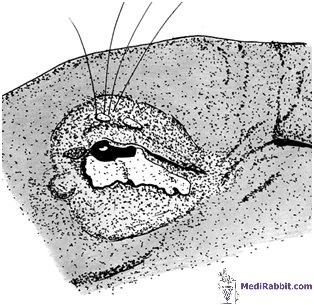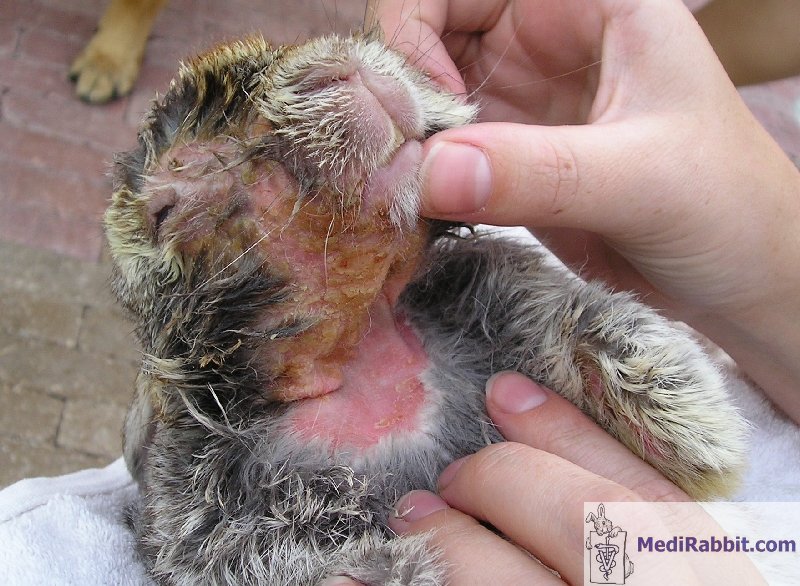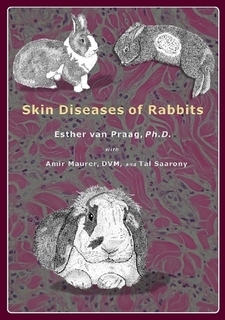Myxomatose
Esther
van Praag, Ph.D. - Oversettelse av Camilla Bergstrøm
|
MediRabbit.com is funded solely by the
generosity of donors. Every donation, no matter what the size, is appreciated and will aid
in the continuing research of medical care and health of rabbits. Thank
you |
Advarsel: Denne artikkelen inneholder bilder som
kan virke støtende
Denne sykdommen har sin
opprinnelse i Uruguay, og ble oppdaget av Sanarelli i 1896. Man oppdaget fort
at den europeiske villkaninen, (Oryctolagus cuniculi) var svært følsom
for dette viruset, og at det forårsaket alvorlige abscesser i huden, før det
lidende dyret omsider døde. Viruset spredde seg over hele det amerikanske
kontinentet, og er fremdeles endemisk i enkelte regioner (Chili, in O.
cuniculi; Western USA, in Sylvilagus bachmani).
På 1950-tallet ble myxomatose-viruset introdusert, og
spredt blant villkaniner i Australia, for å redusere bestanden. Denne
virksomheten drepte nesten hele bestanden, bortsett fra et lite fåtall som så
ut til å være motstandsdyktige for viruset. Kaninene som overlevde begynte å
formere seg, og koloniserte landet på nytt. I Europa spredte viruset seg
raskt og ble endemisk i enkelte regioner
De gruppene av Lagomorpher
(haredyr) som er verst rammet av Myxomviruset er den Europeiske villkaninen (Oryctolagus
cuniculi), den Europeiske haren (Lepus europaeus), den amerikanske
børstekaninen (Sylvilagus bachmani) og den østamerikanske villkaninen
(S. floridanus).
Myxomatose forårsakes av et virus som tilhører
poxvirusene. Det finnes flere forskjellige stammer av dette viruset. Noen er
ondartede og andre gir seg til kjenne gjennom kroniske symptomer. The later comprises close related viruses
that affect he American cottontail rabbit (Sylvilagus sp.) and the
“hare fibroma virus”, among others. All these viruses lead to the development
of tumors of the skin connective tissues (fibroma). Various strains exist.
Some are very virulent (e.g. Standard laboratory, Lausanne, California),
others manifest their presence chronically. Genetic studies show a
relationship between the myxoma and the Shope fibroma virus Sykdommen spres hovedsakelig
av insekter som lopper, mygg, lus og midd. Det spekuleres også i om viruset
kan spres fra en kanin til en annen via kontakt med hud og pels. It was
observed that the virus is present in the mouth’s parts of the rabbit flea Spilopsyllus
cuniculi, where it can survive over 100 days, independently of the
environmental conditions. It is furthermore speculated that the disease may
spread from one rabbit to another during skin and fur contact.
Symptomer
Hvor alvorlig sykdommen er
avhengig av hvor aggressiv virusstammen er. De første symptomene kommer til
syne allerede 3 dager etter at kaninen er smittet. først svulmer øyelokkene
opp (ødem), deretter leppene, kjønnsorganene og kaninen får konjunktivitt
(bindehinnekatarr). I denne fasen av sykdommen blir kaninen blind. Dødsfall
inntreffer vanligvis 8-15 dager etter smitte av myxomviruset.
Når sykdommen er kronisk er det
mest fremtredende symptomet dannelse av svulster i huden på ører, nese og
bein. Disse svulstene vil forsvinne av seg selv etter en tid.
En sideeffekt av den kroniske
formen av sykdommen er sekundære bakterieinfeksjoner. Lungebetennelse
forårsaket av Pasteurella spp eller Staphylococcus aureus er
vanlig, og følges ofte av dyspnoe (åndenød).
Diagnose
Although the disease depends on the strain of myxoma
virus, it is usually severe and almost always fatal. De kliniske symptomene bør være tilstrekkelig for å
stille diagnosen. I sykdommens startfase må de ikke forveksles med symptomene
for spiroketose (treponematose), en sykdom som rammer det perianale området.
Svulstene som oppstår ved disse sykdommene har mange likhetstrekk. Myxomatose
må heller ikke forveksles med infeksjon i de øvre luftveier - Pasteurellose.
Hevelser i det perianale området oppstår kun ved myxomatose.
Hvis tilfellet av myxomatose er kronisk, anbefales
biopsi for å sjekke om det er virus tilstedet. Behandling
Hvis en kanin er rammet av den aggressive
formen av myxomatose, er overlevelsessjansen nesten lik null. I dette
tilfellet er det mest humant å avlive det syke dyret. Hvis man velger å behandle kaninen vil det bety
intensiv behandling over lengre tid. Det er viktig å holde den syke
kaninen i varme omgivelser (21-22 °C). Ører og øyne må rengjøres med jevne
mellomrom. Man bør gi kaninen så mye mat og væske som overhodet mulig, selv
om kaninen drikker godt med vann på egenhånd. Svulster i huden kan fjernes
kirurgisk. Dessverre oppstår det ofte sekundære
komplikasjoner. De vanligste er luftveissykdom og lungebetennelse på grunn av
en sekundærinfeksjon forårsaket av Pasteurella spp. eller Staphylococcus spp. Kaniner som lider av den kroniske formen av
myxomatose kommer seg igjen på egenhånd. Antibiotika kan gis for å unngå
luftveiskomplikasjoner. Depending on the vaccine used and the age or breed of rabbits,
vaccinated rabbits may develop a mild to serious form of the disease. In rare
cases, the rabbit must be put to sleep.
For detailed
information on myxomatosis in rabbits, by E. van Praag, A. Maurer and T. Saarony, 408 pages, 2010. Takk til...
A special thanks to Denise Baart, for
sharing the pictures of her rabbit Bucks. Videre informasjon
Best SM,
Collins SV, Kerr PJ. Coevolution of host and virus: cellular localization of
virus in myxoma virus infection of resistant and susceptible European
rabbits. Virology. 2000; 277(1):76-91. Boag B.
Observations on the seasonal incidence of myxomatosis and its interactions
with helminth parasites in the European rabbit (Oryctolagus cuniculus). J
Wildl Dis. 1988; 24(3):450-5. Boag B,
Lello J, Fenton A, Tompkins DM, Hudson PJ. Patterns of parasite aggregation
in the wild European rabbit (Oryctolagus cuniculus). Int J Parasitol.
2001; 31(13):1421-8. Calvete C,
Estrada R, Villafuerte R, Osacar JJ, Lucientes J. Epidemiology of viral
haemorrhagic disease and myxomatosis in a free-living population of wild
rabbits. Vet Rec. 2002; 150(25):776-82. Chapple
PJ, Lewis ND. Myxomatosis and the rabbit flea. Nature. 1965; 207(995):388-9. Chapuis
JL, Chantal J, Bijlenga G. Myxomatosis in the sub-antarctic islands of
Kerguelen, without vectors, thirty years after its introduction. C R Acad Sci
III. 1994; 317(2):174-82. Duclos P,
Caillet J, Javelot P. Aerobic bacterial flora of the nasal cavity of rabbits.
Ann Rech
Vet. 1986; 17(2):185-90. Edmonds
JW, Nolan IF, Shepherd RC, Gocs A. Myxomatosis: the
virulence of field strains of myxoma virus in a population of wild rabbits (Oryctolagus
cuniculus L.) with high resistance to myxomatosis. J Hyg (Lond). 1975;
74(3):417-8. Flowerdew
JR, Trout RC, Ross J. Myxomatosis: population dynamics of rabbits (Oryctolagus
cuniculus Linnaeus, 1758) and ecological effects in the United Kingdom.
Rev Sci Tech. 1992; 11(4):1109-13. Fountain
S, Holland MK, Hinds LA, Janssens PA, Kerr PJ. Interstitial orchitis with
impaired steroidogenesis and spermatogenesis in the testes of rabbits
infected with an attenuated strain of myxoma virus. J Reprod Fertil. 1997;
110(1):161-9. Ghram A,
Benzarti M, Amira A, Amara A. Myxomatosis in Tunisia: seroepidemiological
study in the Monastir region (Tunisia). Arch Inst Pasteur Tunis. 1996;
73(3-4):167-72. Gorski J,
Mizak B, Chrobocinska M. Control of rabbit myxomatosis in Poland. Rev Sci
Tech. 1994; 13(3):869-79. Jiran E,
Sladka M, Kunstyr I. Myxomatosis of rabbits--study of virus modification.
Zentralbl Veterinarmed B. 1970; 17(3):418-28. Joubert L,
Tuaillon P, Larbaigt G. Serologic and allergologic relationship between
rabbit myxomatosis and fibromatosis viruses. Conglutination reaction and
homologous and heterologous hypersensitivity. Bull Acad Vet Fr. 1970;
43(6):259-76. Joubert L,
Oudar J, Mouchet J, Hannoun C. Transmission of myxomatosis by mosquitoes in
Camargue. Preeminent role of Aedes caspius and Anopheles of the
maculipennis group. Bull Acad Vet Fr. 1967; 40(7):315-22. Kerr PJ,
Merchant JC, Silvers L, Hood GM, Robinson AJ. Monitoring the spread of myxoma
virus in rabbit Oryctolagus cuniculus populations on the southern
tablelands of New South Wales, Australia. II. Selection of a strain of virus
for release. Epidemiol Infect. 2003; 130(1):123-33. Kerr PJ,
Best SM. Myxoma virus in rabbits. Rev Sci Tech. 1998; 17(1):256-68. Lawton MP.
Myxomatosis vaccine. Vet Rec. 1992; 130(18):407-8. Licon Luna
RM. First report of myxomatosis in Mexico. J Wildl Dis. 2000; 36(3):580-3. Marcato
PS, Simoni P. Ultrastructural researches on rabbit myxomatosis. Lymphnodal
lesions. Vet Pathol. 1977; 14(4):361-7. Marlier D,
Mainil J, Linde A, Vindevogel H.
Infectious agents associated with rabbit pneumonia: isolation of
amyxomatous myxoma virus strains. Vet J. 2000; 159(2):171-8. Merchant
JC, Kerr PJ, Simms NG, Robinson AJ. Monitoring the spread of myxoma virus in
rabbit Oryctolagus cuniculus populations on the southern tablelands of
New South Wales, Australia. I. Natural occurrence of myxomatosis. Epidemiol
Infect. 2003; 130(1):113-21. Merchant
JC, Kerr PJ, Simms NG, Hood GM, Pech RP, Robinson AJ. Monitoring the spread
of myxoma virus in rabbit Oryctolagus cuniculus populations on the
southern tablelands of New South Wales, Australia. III. Release, persistence
and rate of spread of an identifiable strain of myxoma virus. Epidemiol
Infect. 2003; 130(1):135-47. Nash P,
Barrett J, Cao JX, Hota-Mitchell S, Lalani AS, Everett H, Xu XM, Robichaud J,
Hnatiuk S, Ainslie C, Seet BT, McFadden G. Immunomodulation by viruses: the
myxoma virus story. Immunol Rev. 1999; 168:103-20. Omori M,
Banfield WG. Shope fibroma and rabbit myxoma factories: electron microscopic
observations. J Electron Microsc (Tokyo). 1970; 19(4):381-3. Patterson-Kane
J. Study of localised dermatosis in rabbits caused by myxomatosis. Vet Rec.
2003; 152(10):308. Patton NM,
Holmes HT. Myxomatosis in domestic rabbits in Oregon. J Am Vet Med Assoc.
1977; 171(6):560-2. Regnery
DC. The epidemic potential of Brazilian myxoma virus (Lausanne strain) for
three species of North American cottontails. Am J Epidemiol. 1971;
94(5):514-9. Regnery
DC, Miller JH. A myxoma virus epizootic in a brush rabbit population. J Wildl
Dis. 1972; 8(4):327-31. Robinson
AJ, Muller WJ, Braid AL, Kerr PJ. The effect of buprenorphine on the course
of disease in laboratory rabbits infected with myxoma virus. Lab Anim. 1999;
33(3):252-7. Ross J.
Myxomatosis and the rabbit. Br Vet J. 1972; 128(4):172-6. Ross J,
Tittensor AM. The establishment and spread of myxomatosis and its effect on
rabbit populations. Philos Trans R Soc Lond B Biol Sci. 1986;
314(1167):599-606. Ross J,
Sanders MF. The development of genetic resistance to myxomatosis in wild
rabbits in Britain. J Hyg (Lond). 1984; 92(3):255-61. Ross J,
Tittensor AM, Fox AP, Sanders MF. Myxomatosis in farmland rabbit populations
in England and Wales. Epidemiol Infect. 1989; 103(2):333-57. Ross J,
Sanders MF. Changes in the virulence of myxoma virus strains in Britain.
Epidemiol Infect. 1987; 98(1):113-7. Rothschild
M. Myxomatosis and the rabbit flea. Nature. 1965; 207(2):1162-3. Sellers
RF. Possible windborne spread of myxomatosis to England in 1953. Epidemiol
Infect. 1987 Feb;98(1):119-25 Shepherd
RC. Myxomatosis: the occurrence of Spilopsyllus cuniculi (Dale) larvae
on dead rabbit kittens. J Hyg (Lond). 1978; 80(3):427-9. Shepherd
RC, Edmonds JW. Myxomatosis: the release and spread of the European rabbit
flea Spilopsyllus cuniculi (Dale) in the Central District of Victoria.
J Hyg (Lond). 1979; 83(2):285-94. Sobey WR,
Conolly D, Haycockp, Edmonds JW. Myxomatosis. The effect of age upon survival
of wild and domestic rabbits (Oryctolagus cuniculus) with a degree of
genetic resistance and unselected domestic rabbits infected with myxoma
virus. J Hyg (Lond). 1970; 68(1):137-49. Sobey WR,
Conolly D. Myxomatosis: passive immunity in the offspring of immune rabbits (Oryctolagus
cuniculus) infested with fleas (Spilopsyllus cuniculi Dale) and exposed
to myxoma virus. J Hyg (Lond). 1975;
74(1):43-55. Torres JM,
Sanchez C, Ramirez MA, Morales M, Barcena J, Ferrer
J, Espuna E, Pages-Mante A, Sanchez-Vizcaino JM. First field trial of a transmissible
recombinant vaccine against myxomatosis and rabbit hemorrhagic disease.
Vaccine. 2001; 19(31):4536-43. Trout RC,
Ross J, Fox AP. Does myxomatosis still regulate numbers of rabbits (Oryctolagus
cuniculus Linnaeus, 1758) in the United Kingdom? Rev Sci Tech. 1993;
12(1):35-8. Werffeli
F. Observations on the appearance of a clinically atypical manifestation of
myxomatosis in wild and domestic rabbits. Schweiz Arch Tierheilkd. 1967;
109(1):9-16. Williams
RT, Dunsmore JD, Parer I. Evidence for the existence of latent myxoma virus
in rabbits (Oryctolaqus cuniculus (L.)). Nature. 1972;
238(5359):99-101. Wunderwald
C, Hoop RK, Not I, Grest P. Myxomatosis in the rabbit. Schweiz Arch
Tierheilkd. 2001; 143(11):555-8 Zuniga MC. Lessons in D tente or know thy host: The immunomodulatory
gene products of myxoma virus. J
Biosci. 2003; 28(3):273-85. |
e-mail: info@medirabbit.com











